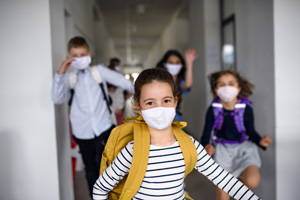Masks & Vaccines: Tools to Continue In-School Education

The US Centers for Disease Control and Prevention recommends that everyone age 5 and older get a COVID-19 vaccine to help protect against COVID-19. Vaccination is the leading public health prevention strategy to end the COVID-19 pandemic.
In addition, the CDC currently recommends universal indoor masking by all students (age 2 and older), staff, teachers, and visitors to K-12 schools, regardless of vaccination status.
Fears about needles and shots
Many children, including teens, are afraid of getting shots of any kind. Children with ADHD may have a harder time handling sensations like pain and may have more difficulty managing their fears. Be sure to talk with your child, validate, and address any fears head on.
Being afraid of needles for shots is not a choice. When you talk with your child, avoid shame and let your child know the fear isn’t about real harm—it’s like one part of t
e brain is playing tricks on other parts, and that means the fear can be managed. Deep-breathing exercises or distractions like watching videos can help. Parents also can help by checking in with themselves and dealing with any of their own concerns over shots so that their children might not pick up on these fears.
Parents with questions about COVID-19 and any other vaccine can also talk to their healthcare providers to learn more about the vaccine and the importance of getting your child vaccinated. Millions of children and adults have already received these vaccines. They have been rigorously studied for safety and effectiveness and received multiple reviews from the US Food and Drug Administration before receiving approval for use. [https://www.cdc.gov/coronavirus/2019-ncov/vaccines/safety/safety-of-vaccines.html]
Healthcare providers can use various methods to decrease the physical sensations for vaccine recipients. They may offer to numb the skin with medication, cold spray, or vibration to help your child avoid feeling the needle. Your provider might have additional ideas about how to address any other fears or concerns your child might have over needles.
Wearing a mask to decrease exposure risks
If your child is new to wearing a mask or face covering, or has sensory issues, mask wearing may also be especially difficult. You can help by keeping sensory needs in mind when picking out a mask: Does your child like soft and smooth textures? What does the fabric smell like? Would straps that go around their head be more conformable than ear loops? Finding a mask that your child likes can improve mask-wearing behaviors. Younger children often like masks that highlight superheroes or popular movies, or they might choose one that has their favorite animal’s nose and whiskers. Older children often like flashy patterns and bold colors.
Masks should fit snugly over your child’s nose and mouth but not be uncomfortable or rub tightly on their cheeks or behind their ears.
Help your child become accustomed to wearing a mask for a few hours at a time. Set aside some time to practice wearing a mask or face covering at home before it’s time to wear one at school or in other public locations. Children learn by observation, so if you wear your own mask during this practice time, your child can follow your example.
Wearing and keeping track of a mask is sometimes a challenge for children who cope with ADHD symptoms. If your child is prone to fidgeting with the mask, brainstorm other ways to fidget when they want to play with the mask. If your child struggles with forgetfulness, make sure to pack an extra mask in their bookbag. A breakaway lanyard attached to one of the ear loops can help prevent loss through masks being dropped on the ground or left on the bus.
Resources:
- Frequently Asked Questions about COVID-19 Vaccination
- Safety of COVID-19 Vaccines
- Use Masks to Slow the Spread of COVID-19
- Your Guide to Masks
- ADHD & COVID-19 Resources Toolkit
- ADHD and School: A Toolkit for Parents
- American Academy of Pediatrics Updates Recommendations for Opening Schools in Fall 2021
- COVID-19 pandemic: Helping young children and parents transition back to school
- COVID-19 Resources for Schools, Students, and Families
